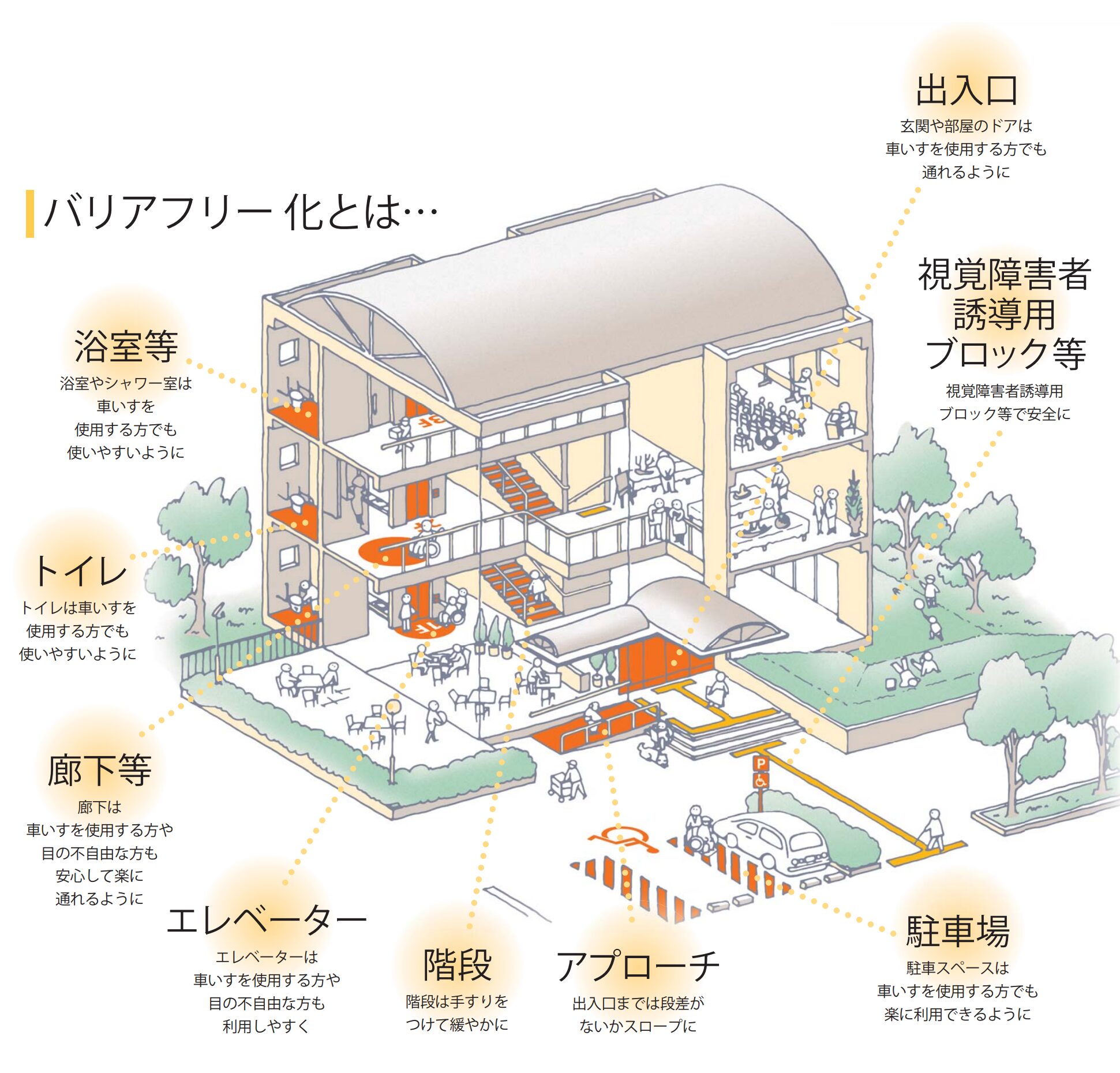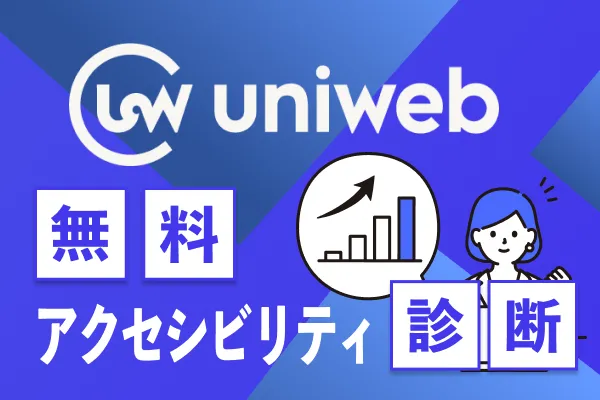Barrier-Free Law is a law that promotes the smooth movement of people and the use of facilities.
2025/01/31

Barrier-Free Access Act(official name: Act on the Promotion of Smooth Mobility for the Elderly and Persons with Disabilities) was enacted in 2006 with the aim of realizing a society in which all people can safely and comfortably move around and use facilities.
The background behind the enactment of this law is,
Universal Design(※)Growing importance of
and other impacts.
Originally, Japan had the Heart Building Law (enacted in 1994), which stipulated barrier-free buildings, and the Transportation Barrier-Free Law (enacted in 2000), which promoted barrier-free transportation.
However, each of these laws promoted barrier-free access from a different perspective, and they were not consistent policies.
So there,The Barrier-Free Law was enacted to integrate these laws and comprehensively make buildings, transportation, and roads barrier-free.
This law is not only for building and transportation improvements,It clarifies the roles that businesses, local governments, and citizens should each play in creating a barrier-free society, and promotes efforts by society as a whole.。
This article provides a detailed explanation of the contents of the Barrier-Free Accessibility Act, as well as the benefits available to businesses, and summarizes important points for promoting barrier-free initiatives in an easy-to-understand manner.
*Related Article:Explanation and examples of the "7 principles" for understanding universal design
Table of Contents
- 1 Three points that the Barrier-Free Law emphasizes
- 2 Revised law further promotes barrier-free access
- 3 Standards for Facilities and Equipment" and "Examples of Compliance" under the Barrier-Free Access Act
- 4 Four advantages of buildings based on the Barrier-Free Law
- 5 A fine of up to 3 million yen is imposed for violations of the Barrier-Free Access Act.
- 6 Conclusion
Three points that the Barrier-Free Law emphasizes
The Ministry of Land, Infrastructure, Transport and Tourism's "Architectural Design Standards for Smooth Mobility of the Elderly and Persons with Disabilities, etc." stipulates the followingBasic Policy of the Barrier-Free Laware defined in detail.
A reading of this policy narrows the Barrier-Free Law's particular emphasis to the following three points.
◆Three points that barrier-free people place importance on
(2) Set standards for barrier-free accessibility and require businesses and municipalities to do so.
(iii) Clarify the roles of the national government, local governments, and businesses.
The Barrier-Free Law promotes barrier-free buildings, transportation facilities, and roads to create an environment in which all people can move easily. Facilities above a certain size are required to meet standards and be barrier-free.
In addition, the national and local governments have set up priority improvement areas to systematically improve the barrier-free environment,Businesses are obligated to provide barrier-free access based on the law or to make efforts to do so.will be imposed, and facilities will be required to be renovated and operationally addressed.
Through this division of roles,The national government establishes the legal system, local governments implement measures according to local conditions, and businesses promote actual barrier-free measures.A cooperative system has been established that
Based on the above three points, the national government, local governments, and businesses will work together to promote barrier-free measures and create an environment in which all people can move around and use facilities with peace of mind.
As a result, the entire society will become more barrier-free, leading to the realization of a society where diverse people can live comfortably.
And to promote these barrier-free measures more effectively,Revision of the Barrier-Free Law in 2018 and 2019The following is an explanation of how the revisions have strengthened and expanded the scope of the program.
Revised law further promotes barrier-free access
The Barrier-Free Law was revised in 2018 and 2019 with the aim of promoting further barrier-free access and creating a symbiotic society on the occasion of the Tokyo Olympics and Paralympics.
Major Revisionsare as follows
Clarification of basic principles
Barrier-free measures areBasic legal principles that contribute to the "realization of a symbiotic society" and the "elimination of social barriers" are clearly stated as basic principles.In addition to the conventional hard aspects (maintenance of facilities), the importance of soft aspects (mental barrier-free and provision of information) was also clarified.
Promote barrier-free public transportation facilities and buildings, etc.
In addition to conventional transportation facilities such as railroads, buses, and airports, charter buses and sightseeing boats are newly covered, and operators are not only obliged to install barrier-free facilities,Soft aspects such as provision of information and employee hospitality trainingare now also required.
Promotion of priority and integrated barrier-free accessibility in the region
Each municipality has Policy for Facilitation of Mobility (Master Plan)" (Japanese only) In addition, a system has been introduced to systematically promote barrier-free development in accordance with the characteristics of each region, and districts that should be given priority for barrier-free development are designated as follows."Priority areas for rehabilitation"The new system also allows for designation as a
Promotion of Barrier-Free Mind
In order to promote barrier-free access not only through physical improvements, but also through a change in the awareness of society as a whole, we will clearly promote the understanding and cooperation of each and every citizen,Mechanisms for parties concerned (the elderly and persons with disabilities) to participate in the evaluation of barrier-free measureshas been introduced.
The revised Barrier-Free Law does not merely promote barrier-free facilities,A system to promote barrier-free access throughout societyGoing forward, further efforts will be required to realize a society in which all people can live comfortably, while taking advantage of the purpose of the revised law.
Reference: Revised Barrier-Free Law (Ministry of Land, Infrastructure, Transport and Tourism)
Next, we will explain the scope and criteria of the Barrier-Free Law.
Standards for Facilities and Equipment" and "Examples of Compliance" under the Barrier-Free Access Act
The Barrier-Free Law requires various facilities to be barrier-free in order to create an environment in which all people can move around and use the facilities comfortably.
Here, we will discuss the specific efforts to achieve barrier-free accessibility from two perspectives: What specific facilities and equipment are covered, and what standards and responses are required?The following table organizes some examples of the
◆Facilities and equipment standards and examples of compliance with the Barrier-Free Access Act
| field | Target Facilities and Equipment | Barrier-free points | Major Criteria and Examples of Responses |
| buildings | Commercial facilities, hospitals, hotels, theaters, government offices | Elimination of steps at entrances and exits, installation of elevators and multipurpose restrooms, etc. | Minimum width of entrances and exits (80 cm or more) Elevator sizing (minimum 135cm depth and 160cm width) Handrails installed in multipurpose restrooms, wheelchair-accessible space |
| Schools, welfare facilities, office buildings | Installation of ramps, elevators, guidance systems for the visually impaired, etc. | Obligation to install elevators (above a certain size) Installation of Braille blocks |
|
| Condominiums and apartments (above a certain size) | Barrier-free design of common areas (elevators, corridor widths), etc. | Barrier-free facilities in common spaces | |
| Transportation | Train stations, bus terminals, airports, ferries | Installation of elevators, Braille blocks, wheelchair-accessible ticket gates, etc. | Obligation to install elevators Proper placement of Braille blocks |
| Non-step buses, UD cabs | Space for wheelchairs and strollers, structure for easy boarding and disembarking | More than a certain number of vehicles will be made barrier-free vehicles. | |
| railroad vehicle | Space for wheelchairs and strollers, and doors designed for easy entry and exit | Secure wheelchair spaces (at least 2 spaces per train, at least 3 spaces per train for Shinkansen, etc.) Handrail placement |
|
| Roads and Public Facilities | Intersections, sidewalks, parks, public squares | Installation of ramps and barrier-free walkways | Installation of wheelchair ramps Sidewalk width Installation of Braille blocks |
| traffic light | Safety measures for the visually impaired | Acoustic signal placement | |
| Ramps, pedestrian bridges | Elimination of steps and installation of handrails to prevent falls | Slope of slope (1/12 or less for indoors, 1/15 or less for outdoors) Durable handrail material, installed on both sides |
Although the table above summarizes some typical examples, the scope of the Barrier-Free Law is broad and includes not only buildings such as commercial facilities and hospitals, but also transportation facilities such as railroads and buses, and even public spaces such as sidewalks and parks.
It is also clear that the standards for barrier-free accessibility are not limited to the mere elimination of steps and installation of elevators, but also include Braille blocks for the visually impaired, acoustic traffic signals, and a wide range of other features.
Thus, the Barrier-Free Act isIt is characterized by its comprehensive definition of not only "ease of movement" but also "ease of use of facilities."
For example, even in a single building, barrier-free accessibility is required at many points, as shown below.
◆Points for Barrier-Free in Buildings
Source:Let's build a building with heart (Ministry of Land, Infrastructure, Transport and Tourism)
By implementing barrier-free construction in every detail in accordance with the Barrier-Free Law, the building will be accessible to everyone, including the elderly and disabled as well as children and pregnant women.
Barrier-free laws have specific standards, but not all are mandatory.
Although the Barrier-Free Act has clear standards,Not all facilities have unconditional obligations。
For example, though new construction and major renovations of buildings are required to apply barrier-free standards,Existing buildings and transportation systems are required to "accommodate as much as possible," the so-called "scope of effort."In some cases, the number of cases remains only at
Also in transportation, stations and bus terminals are obligated to meet the standards, while the introduction of non-step buses and universal design cabs is an effort obligation.
Thus, not all facilities and equipment are uniformly required to be barrier-free,Coverage varies depending on the type of facility and timing of the renovation.
Now, we will discuss the benefits of implementing initiatives based on the Barrier-Free Law.
Four advantages of buildings based on the Barrier-Free Law
Taking action in accordance with the Barrier-Free Law not only has social benefits,Specific benefits to be gained by the businessHere are some specific benefits, using buildings in particular as examples.
Barrier-free access was implemented,When a specified building is certified by the competent administrative agency as being in compliance with the standards for facilitating building movement, etc.The following benefits can be obtained
Advantage 1: Special floor-area ratio rules apply.
To provide the space needed to accommodate barrier-free access (e.g., wheelchair-accessible restrooms, wider hallways, etc.),Excluded from the calculation of floor area ratio up to 1/10 of the total floor areaThe following is a list of the most common types of products that can be used in the market.
This allows for greater flexibility in architectural planning and effective utilization of the entire facility.
Advantage 2: Special tax measures are available.
For certified special specified buildings (with a total floor area of 2,000 square meters or more, but less than 50,000 square meters, and with an elevator),Surcharge for income and corporate taxes (10%, 5 years) is applied.
This allows for barrier-free accessibility while reducing the initial investment burden.
Advantage 3) Utilization of subsidies and low-interest loans
For buildings that promote barrier-free access,National and local government subsidy programs and low-interest loan programs such as Japan Finance Corporationmay be available.
By utilizing these support measures, it will be possible to promote barrier-free facilities while reducing the financial burden on businesses.
Advantage 4: PR effect by displaying the symbol mark
For buildings certified under the Barrier-Free Law,Hartville Mark." can be displayed.
This symbol mark indicates that the facility is fully barrier-free and provides users with a sense of security,To be evaluated as a corporate social responsibility (CSR) activity as wellThis will promote the use of the facility and improve its image.
The advantages listed above are,Adapted from the Ministry of Land, Infrastructure, Transport and Tourism's pamphlet "Let's Build a Building with HeartPlease read this document in conjunction with this article for a detailed explanation of the importance of barrier-free construction and the specific benefits available to businesses.
Citation: Let's build a building with heart (Ministry of Land, Infrastructure, Transport and Tourism)
In this section, we have described the benefits that can be gained by taking steps in accordance with the Barrier-Free Act.
The following section explains the penalties for failure to comply with the Barrier-Free Access Act.
A fine of up to 3 million yen is imposed for violations of the Barrier-Free Access Act.
Many people are concerned about the penalties for violating the Barrier-Free Access Act.
For the Barrier-Free Act,Fines of up to 3 million yen are imposed on businesses that do not comply with orders from the local government.すThe provision is established that
This isWhen a building or public transportation facility does not comply with barrier-free standards, the local government issues an order to correct the situation and the user fails to comply with the order.This applies to
Specifically, penalties will be applied based on the following provisions
◆ Penalties stipulated in the Barrier-Free Access Act (summary)
Article 59:
Violation of Article 9, Paragraph 3 (Obligation to make specified buildings barrier-free), Article 12, Paragraph 3 (Obligation to make public transportation barrier-free), or Article 15, Paragraph 1 (Barrier-free measures in priority improvement areas), and failure to comply with orders from the local government,Fine of up to 3,000,000 yenis imposed.
Article 60:
For other violations of regulations,Fine of up to 1,000,000 yenThe following are the reasons why the Company may impose a penalty of up to one hundred thousand yen
Citation and summary:Act on Promotion of Smooth Mobility for the Elderly and Persons with Disabilities, etc.
Thus, the Barrier-Free Law contains mandatory provisions with penalties and a system of legal action for certain violations.
The penalties in the Barrier-Free Act are not intended merely to punish businesses,Measures to promote a barrier-free environment in a mandatory manner.
In particular, penalties for violation of the order have been established for facilities that are used by many people, such as commercial facilities and public transportation, because failure to meet barrier-free standards can have a significant impact on society as a whole.
Also, though there are penalties,The Barrier-Free Access Act basically emphasizes "promotion through incentives (subsidies, etc.)" rather than "deterrence through penalties.Rather than cracking down on violations, the focus is on measures in the direction of increasing barrier-free access.
No penalties are imposed within the scope of the obligation to make efforts.
As noted earlier, the Barrier-Free Act does not impose a uniform mandate on all facilities,They are divided into "obligation" and "effort obligation" depending on the type of facility and situation.
One aspect of barrier-free accessibility is that it is too costly to renovate and install new equipment, so forcing all businesses to do so would place too great an economic burden on them.
Therefore, the "effort obligation" is designed to encourage as much action as possible in areas where it is difficult to make it obligatory.
However, although there is no penalty,It is important to note that failure to make the effort may result in disadvantages to the business.
◆Disadvantages that may result from failure to make efforts
Damage to corporate image due to inadequate barrier-free access
Decrease in convenience for users and impact on customer attraction
Thus, even in the absence of penalties, proactive measures are recommended, even within the scope of the obligation to make efforts, because of the potential social and economic impact.
Conclusion
The Barrier-Free Law is a law to realize a society in which all people, including the elderly and people with disabilities, can safely and comfortably move around and use facilities. It is an important guideline to realize a symbiotic society by creating an environment in which everyone has equal access in today's increasingly diverse society.
Barrier-free access not only benefits users and society,Use of floor-area ratio relaxations, tax incentives, and subsidiesThis is a measure that is highly significant for businesses to proactively engage in, as they can also benefit from such advantages as the following
In this article, we have explained in detail about the barrier-free method and how it is actually incorporated,The following articles introduce specific barrier-free initiatives, and you can read more about them in the following articlesPlease take a look at the following pages.
Related Articles:Thorough explanation of 13 specific examples to deepen understanding of "barrier-free".
-
Contact Us
-
Request Info
-
Free Trial
-
Partner System








